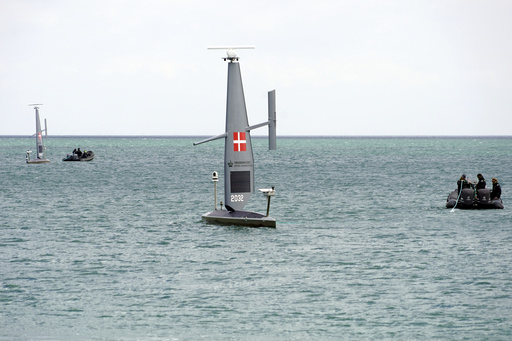In the peaceful waters of Koge Marina, Denmark, an innovative fleet of uncrewed sailboats has been launched, marking a significant step in maritime surveillance. From afar, these vessels, each adorned with Denmark’s iconic red-and-white flag, could be mistaken for regular sailboats. However, these 10-meter (30-foot) robotic vessels are anything but ordinary. Designed for monitoring purposes, they operate without a human crew and have been deployed by Denmark’s armed forces for a three-month operational trial.
These state-of-the-art sailboats, termed “Voyagers,” are the brainchild of Saildrone, a company based in Alameda, California. Their mission will encompass patrolling the Danish and NATO territories in the Baltic and North Seas, regions that have seen rising tensions and suspected acts of sabotage since Russia’s incursion into Ukraine began on February 24, 2022.
Starting their journey from Koge Marina, around 40 kilometers (25 miles) from Copenhagen, two of these Voyagers set sail powered by renewable energy sources—wind and solar. They boast impressive autonomy, potentially sailing the seas without human intervention for extended periods. Equipped with cutting-edge technology, these drones carry an array of sensors, including radar, infrared, optical cameras, sonar, and acoustic monitoring tools.
Their launch marks the continuation of efforts, with two other Voyagers already participating in a NATO exercise since June 6. Richard Jenkins, Saildrone’s founder and CEO, described these vessels as akin to a “truck” loaded with sensors. Their powerful combination of machine learning and artificial intelligence provides a comprehensive view of maritime activities within a 20 to 30 miles (30 to 50 kilometers) radius.
Jenkins emphasized the importance of these drones as unobserved maritime threats like disruptions to underwater cables, illegal fishing, and contraband trafficking remain prevalent due to the lack of surveillance. Saildrone’s technology aims to fill these gaps by providing eyes and ears in previously unmonitored areas.
According to Denmark’s Defense Ministry, the trial’s objective is to enhance surveillance capabilities in areas with limited monitoring, particularly around vital undersea infrastructure like fiber-optic cables and power lines. Lt. Gen. Kim Jørgensen, the director of Danish National Armaments, highlighted the tense security environment in the Baltic region. The Voyagers will first navigate Danish waters before integrating with NATO exercises and shifting locations within Danish territories.
These trials are crucial as NATO faces mounting threats to maritime infrastructure, illustrated by incidents such as the 2022 Nord Stream pipeline explosions and the destruction of at least 11 undersea cables since late 2023, with a notable break in January severing the link between Latvia and Sweden’s Gotland island.
This initiative occurs amidst broader geopolitical tensions, including trans-Atlantic friction due to former U.S. President Donald Trump’s administration’s controversial interest in Greenland, a Danish territory. Although Saildrone had already planned its Danish operations before this controversy, Jenkins refrained from discussing the political implications, maintaining a non-political stance for the company.
Certain maritime incidents are attributed to Russia’s so-called shadow fleet, comprising aging oil tankers operating under ambiguous ownership to evade sanctions. For example, Finnish authorities detained the Eagle S in December, suspecting it of damaging a power cable between Finland and Estonia with its anchor. Western officials have accused Russia of leading covert attacks both at sea and on land.
To tackle these challenges, NATO is working towards establishing a comprehensive maritime surveillance system that integrates uncrewed surface vessels like the Voyagers with conventional naval ships, satellites, and seabed sensors.
“The challenge remains the need for constant presence on the water, a costly endeavor,” explained Peter Viggo Jakobsen from the Royal Danish Defense College. It is financially unfeasible to trail every suspected vessel, whether military or civilian, with warships.
He further elaborated that the aim is to develop a layered surveillance approach, allowing for the continuous monitoring of potential threats while significantly reducing costs. This innovative surveillance system could potentially transform maritime security in the region.



